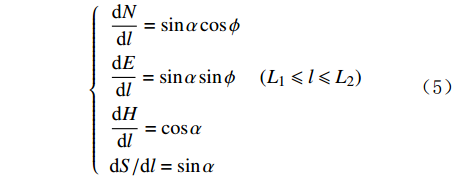Numerical Integral Calculation in Borehole Trajectory Model
-
摘要:
为了提高钻井设计软件中所使用定积分的计算速度,从井眼轨道模型的基本公式出发,经过积分参数变换,将恒工具面法北东坐标定积分中的被积函数需要7次三角函数和1次对数函数的运算减少为3次三角函数和1次对数函数的运算,将空间圆弧法水平投影长度定积分的被积函数中的三角函数运算简化掉,从而提高定积分的计算速度;使用变步长Simpson数值积分公式,计算恒工具面法北东坐标定积分和空间圆弧法水平投影长度定积分,可将计算精度控制到任意精度。算例计算表明,本文算法除了提高了计算速度,计算精度还与公开数据完全相同。本文给出的算法是对井眼轨道计算的进一步改进和完善,可应用于钻井软件开发中。
Abstract:In order to improve calculation speed of the definite integrals in the drilling design software, the basic formula of the borehole trajectory model and the integral parameter conversion were adopted. The calculation of seven trigonometric and one logarithmic functions was reduced to that of three trigonometric and one logarithmic functions required by the integrand of the definite integral in the north and east coordinates by the constant tool face method. The trigonometric functions in the integrand of the definite integral with a horizontal projection length by the space arc method were simplified, so as to improve the calculation speed of the definite integral. Using the variable step size Simpson numerical integration formula to calculate the above two kinds of definite integrals, the calculation accuracy can be controlled to arbitrary precision. The calculation shows that the new algorithm in this paper not only improves the calculation speed but also has the same calculation accuracy as the public data. The algorithm given in this paper is further improves and refines of the borehole trajectory calculation and can be applied in the software development of drilling.
-
在进行井眼轨道设计[1-7]、随钻测量数据处理时[8-15],需要计算北东坐标、垂深、水平投影长度等参数,如果井眼轨道上每一点的井斜角和方位角与井深呈线性关系,则这些参数可以通过解析计算公式计算;如果井斜角或者方位角与井深呈非线性关系,则北东坐标或者水平投影长度就需要使用数值积分法来计算[16]。刘修善[16]提出采用定积分表示这些参数,但是并没有详细说明如何计算这些定积分。鲁港等人[17-18]推导出了空间圆弧轨道的井斜角计算公式,并使用数值积分法来计算水平投影长度[19]。对于恒工具面模型,还没有查阅到讨论如何计算北东坐标数值积分的公开文献,而开发钻井软件过程中,也会遇到恒工具面模型北东坐标数值积分的问题,因此,笔者对积分参数进行了数学变换,使积分函数进一步化简,从而快速计算数值积分。
1. 井眼轨道模型
井眼轨道在数学上可以抽象为三维空间中的光滑曲线,这意味曲线上的每一点处都有切线,并且切线随切点的移动而连续转动。
以井口为坐标原点
O ,以正北方向为x轴,以正东方向为y轴,以指向地心方向为z轴,建立三维直角坐标系O-xyz,称为整体坐标系,也称为井眼坐标系。1.1 井眼轨道微分方程
井眼坐标系中井眼轨道参数可以写成下面的形式:
{N=f(l)E=g(l)(L1⩽ (1) 式中:
N 为北坐标,m;E 为东坐标,m;H 为垂深,m;l 为井深,m;{L_1} 为起始井深,m;{L_2} 为结束井深,m;f(l) ,g(l) 和h(l) 均为井深l 的函数。式(1)也可以写成更简洁的矢量形式:
{\boldsymbol{r}} = {\boldsymbol{r}}(l) = \left[ {\begin{array}{*{20}{c}} {f(l)} \\ {g(l)} \\ {h(l)} \end{array}} \right]{\text{ }}({L_1} \leqslant l \leqslant {L_2}) (2) 式中:
{\boldsymbol{r}} 为位置矢量;{\boldsymbol{r}}(l) 为井深l 的矢量函数。切线矢量
{\boldsymbol{t}} 定义为:{\boldsymbol{t}} = \frac{{{\boldsymbol{\dot r}}}}{{\left\| {{\boldsymbol{\dot r}}} \right\|}} = \frac{1}{{\sqrt {{{[f'(l)]}^2} + {{[g'(l)]}^2} + {{[h'(l)]}^2}} }}\left[ {\begin{array}{*{20}{c}} {f'(l)} \\ {g'(l)} \\ {h'(l)} \end{array}} \right] (3) 井眼轨道的光滑性要求
{[f'(l)]^2} + {[g'(l)]^2} + {[h'(l)]^2} \ne 0 。切线矢量是单位长度矢量,也称为井眼方向矢量,它与z轴的夹角为井斜角,记为
\alpha ;x轴顺时针转到切线矢量水平投影所转过的角度为井斜方位角,简称方位角,记为\phi 。因此切线矢量可写为[17-23]:{\boldsymbol{t}} = \left[ {\begin{array}{*{20}{c}} {\sin\alpha \cos\phi } \\ {\sin\alpha \sin\phi } \\ {\cos\alpha } \end{array}} \right] (4) 式中:
\alpha 为井斜角,rad;\phi 为井斜方位角,rad;{\boldsymbol{t}} 为切线矢量。将井眼轨道投影到水平面上,井眼轨道上任一点
P 在投影曲线上的对应点为P' ,则投影曲线上开始点到P' 的长度称为水平投影长度,记为S 。因此,得到井眼轨道参数的微分表达式:
\left\{ {\begin{array}{*{20}{l}} {\dfrac{{{\text{d}}N}}{{{\text{d}}l}} = \sin \alpha \cos \phi }&{} \\ {\dfrac{{{\text{d}}E}}{{{\text{d}}l}} = \sin \alpha \sin \phi }&{({L_1} \leqslant l \leqslant {L_2})} \\ {\dfrac{{{\text{d}}H}}{{{\text{d}}l}} = \cos \alpha }&{} \\ {{\text{d}}S/{\text{d}}l = \sin \alpha }&{} \end{array}} \right. (5) 式中:
S 为水平投影长度,m。如果已知井斜角和方位角随井深的变化规律,就可以通过式(5)计算出北东坐标、垂深、水平投影长度。
\left\{ {\begin{array}{*{20}{l}} {\Delta N = \displaystyle\int_{{L_1}}^L {\sin \alpha \cos \phi {\text{d}}l} } \\ {\Delta E = \displaystyle\int_{{L_1}}^L {\sin \alpha \sin \phi {\text{d}}l} } \\ {\Delta H = \displaystyle\int_{{L_1}}^L {\cos \alpha {\text{d}}l} } \\ {\Delta S = \displaystyle\int_{{L_1}}^L {\sin \alpha {\text{d}}l} } \end{array}} \right. (6) 式中:
\Delta N 为北坐标增量,m;\Delta E 为东坐标增量,m;\Delta H 为垂深增量,m;\Delta S 为水平投影长度增量,m。1.2 恒工具面模型
恒工具面模型的特征是井眼轨道上每一点的井眼曲率和工具面角保持为常数。
井斜角和方位角的变化规律为[16]:
\, \left\{ {\begin{array}{*{20}{l}} {\alpha = {\alpha _1} + (\kappa \cos \omega )(l - {L_1})} \\ {\phi = {\phi _1} + \tan \omega \left( {\ln \tan \dfrac{\alpha }{2} - \ln \tan \dfrac{{{\alpha _1}}}{2}} \right)} \end{array}} \right.{\text{ }}({L_1} \leqslant l \leqslant {L_2}) (7) 式中:
\kappa 为井眼曲率,rad/m;\omega 为工具面角,rad;{\alpha _1} 和{\phi _1} 分别为起始井深处的井斜角和方位角,rad。垂深、水平投影长度增量的积分形式有封闭形式的表达式,而北东坐标增量的积分一般没有封闭形式的表达式,需要采用数值积分法来计算。
将积分变量转化为
\alpha ,得到:\begin{split} \Delta N =& \frac{1}{{\kappa \cos \omega }}\int_{{\alpha _1}}^\alpha \cos \left[ {{\phi _1} + \tan \omega \left( {\ln \tan \frac{\alpha }{2} - \ln \tan \frac{{{\alpha _1}}}{2}} \right)} \right]\cdot\\ &\sin \alpha {\text{d}}\alpha \\[-10pt] \end{split} (8) 由于
\tan \dfrac{\alpha }{2} = \sqrt {\dfrac{{1 - \cos \alpha }}{{1 + \cos \alpha }}} 、{\text{d}}(\cos \alpha ) = - \sin \alpha {\text{d}}\alpha ,令t = \cos \alpha ,则式(8)变为:\Delta N = \frac{1}{{\kappa \cos \omega }}\int_{\cos {\alpha _1}}^{\cos \alpha } {\cos \left[ {{\phi _1} + \frac{{\tan \omega }}{2}\left( {\ln \frac{{1 - {t_1}}}{{1 + {t_1}}} - \ln \frac{{1 - t}}{{1 + t}}} \right)} \right]{\text{d}}t} (9) 类似地,有:
\Delta E = \frac{{ - 1}}{{\kappa \cos \omega }}\int_{\cos {\alpha _1}}^{\cos \alpha } {\sin \left[ {{\phi _1} + \frac{{\tan \omega }}{2}\left( {\ln \frac{{1 - {t_1}}}{{1 + {t_1}}} - \ln \frac{{1 - t}}{{1 + t}}} \right)} \right]{\text{d}}t} (10) 1.3 空间圆弧模型
空间圆弧模型是空间斜平面上的一段圆弧,井眼曲率为常数。它在水平面上的投影是一段椭圆曲线,所以水平投影长度(积分)没有封闭形式的表达式,需要使用数值积分法来计算。
{\boldsymbol{t}} = {{\boldsymbol{n}}_1}\sin \theta + {{\boldsymbol{t}}_1}\cos \theta (11) \,其中\qquad \qquad\qquad \theta = \kappa (l - {L_1})\quad\qquad (12) {{\boldsymbol{n}}_1} = {{\boldsymbol{h}}_1}\cos {\omega _1} + {{\boldsymbol{v}}_1}\sin {\omega _1} (13) {{\boldsymbol{h}}_1} = \left[ {\begin{array}{*{20}{c}} {\cos {\alpha _1}\cos {\phi _1}} \\ {\cos {\alpha _1}\sin {\phi _1}} \\ { - \sin {\alpha _1}} \end{array}} \right] (14) {{\boldsymbol{v}}_1} = \left[ {\begin{array}{*{20}{c}} { - \sin {\phi _1}} \\ {\cos {\phi _1}} \\ 0 \end{array}} \right] (15) 式中:
\theta 为圆心角,rad;{\omega _1} 为起始井深处的工具面角,rad;{{\boldsymbol{n}}_1} ,{{\boldsymbol{h}}_1} 和{{\boldsymbol{v}}_1} 分别为起始井深处的内法线矢量、井眼高边矢量和方位垂直矢量。如果令
{{\boldsymbol{n}}_1} = {[{a_1},{b_1},{c_1}]^{\text{T}}} ,{n_1} = \cos {\alpha _1} ,则由式(11)得到井斜角的变化规律:\cos \alpha = {c_1}\sin \theta + {n_1}\cos \theta (16) 2. 数值积分
数值积分法需要反复计算被积函数的值,因此在选定了数值积分公式后,要提高数值积分法的计算速度,主要就是减少被积函数所用的计算量。测试了C++语言中正弦函数、余弦函数、对数函数、乘法运算1亿次的用时,共进行了10次测试,结果见表1。测试软件环境为C++Builder 6.0,硬件为Inter i5-700U CPU 2.60 GHz。
表 1 主要数学函数的计算速度Table 1. Calculation speed of major mathematical functions测试序号 运算1亿次的用时/ms 余弦函数 正弦函数 对数函数 乘法 1 4 964 4 521 3 139 282 2 4 960 4 527 3 121 284 3 4 953 4 507 3 135 282 4 4 953 4 505 3 137 282 5 4 975 4 539 3 147 285 6 4 966 4 538 3 142 285 7 4 981 4 542 3 145 285 8 4 970 4 530 3 144 289 9 4 969 4 538 3 142 286 10 4 961 4 522 3 135 287 平均 4965 4527 3139 285 在不同的软硬件环境中,不同函数的计算速度略有不同,但存在这样的统计结论,乘法、对数函数、正弦函数和余弦函数的计算速度从快到慢的排序是乘法、对数函数、正弦函数和余弦函数。因此,进行数值积分计算时,要尽可能地用乘法代替对数和三角函数,能使用对数就尽量不使用三角函数,能使用正弦函数就不使用余弦函数。
2.1 变步长Simpson数值积分法
定积分为:
I = \int_a^b {F{\text{(}}x{\text{)d}}x} (17) 计算该定积分的步骤为[24]:
1)
n = 1 ,h = b - a ,用梯形公式计算。{T_n} = \frac{{F(a) + F(b)}}{2}h (18) 2)用变步长梯形法计算。
{x_k} = a + kh (19) {T_{2n}} = \frac{1}{2}{T_n} + \frac{h}{2}\sum\limits_{k = 0}^{n - 1} {F\left({x_k} + \frac{h}{2}\right)} (20) 3)用Simpson求积公式计算。
{I_{2n}} = \frac{{4{T_{2n}} - {T_n}}}{3} (21) 4)用
{I_n} 表示第n 步计算出来的积分值。如果\left| {{I_{2n}} - {I_n}} \right| < {\varepsilon _1} ,则结束,{I_{2n}} 即为所求积分的近似值。5)如果
\left| {{I_{2n}} - {I_n}} \right| \geqslant {\varepsilon _1} ,令n = 2n ,h = h/2 ,返回2)。{\varepsilon _1} 为给定的精度要求,例如{\varepsilon _1} = 1\times {10^{ - 6}} 。2.2 恒工具面法北东坐标增量的计算
\,令\qquad \qquad \quad{\phi _0} = {\phi _1} + \frac{{\tan \omega }}{2}\ln \frac{{1 - {t_1}}}{{1 + {t_1}}} \quad (22) \varphi = \frac{{\tan \omega }}{2}\ln \frac{{1 - t}}{{1 + t}} (23) 则式(9)中的被积函数可以写成:
\cos ({\phi _0} - \varphi ) = \cos {\phi _0}\cos \varphi + \sin {\phi _0}\sin \varphi (24) 式(10)中的被积函数可以写成:
\sin ({\phi _0} - \varphi ) = \sin {\phi _0}\cos \varphi - \cos {\phi _0}\sin \varphi (25) \,令\qquad \qquad s = \int_{\cos {\alpha _1}}^{\cos \alpha } {\cos \left( {\frac{{\tan \omega }}{2}\ln \frac{{1 - t}}{{1 + t}}} \right){\text{d}}t} \quad (26) c = \int_{\cos {\alpha _1}}^{\cos \alpha } {\sin \left( {\frac{{\tan \omega }}{2}\ln \frac{{1 - t}}{{1 + t}}} \right){\text{d}}t} (27) 则式(9)和式(10)可以写成:
\Delta N = \frac{{s\cos {\phi _0} + c\sin {\phi _0}}}{{\kappa \cos \omega }} (28) \Delta E = \frac{{c\cos {\phi _0} - s\sin {\phi _0}}}{{\kappa \cos \omega }} (29) 由于
\left| s \right| \leqslant 1 ,\left| c \right| \leqslant 1 ,必定存在2个参数r 和{\varphi _0} ,使s = r\sin {\varphi _0} ,c = r\cos {\varphi _0} ,于是式(28)和式(29)可以写成:\Delta N = r\frac{{\sin ({\varphi _0} + {\phi _0})}}{{\kappa \cos \omega }} (30) \Delta E = r\frac{{\cos ({\varphi _0} + {\phi _0})}}{{\kappa \cos \omega }} (31) 变步长Simpson积分算法并不只是用来计算
\Delta N 和\Delta E ,而是使计算\Delta N 和\Delta E 的算法做些稍许改变,使计算\Delta N 和\Delta E 时对数函数的计算次数减少。2.3 空间圆弧法水平投影长度增量的计算
\Delta S = \int_{{L_1}}^L {\sqrt {1 - {{\cos }^2}\alpha } {\text{d}}l} (32) 通过积分参数变换
\theta = \kappa (l - {L_1}) 、{\text{d}}\theta = \kappa {\text{d}}l ,得:\Delta S = \frac{1}{\kappa }\int_0^\varepsilon {\sqrt {1 - {{({c_1}\sin \theta + {n_1}\cos \theta )}^2}} {\text{d}}\theta } (33) 通过以下变换:
{b_2} = \frac{{c_1^2 + n_1^2}}{2} (34) {a_2} = 1 - {b_2} (35) {c_2} = {c_1}{n_1} (36) {r_2} = \sqrt {b_2^2 + c_2^2} (37) {e_2} = \frac{{{a_2}}}{{2{r_2}}} (38) {\gamma _2} = \arctan \frac{{{b_2}}}{{{c_2}}} (39) {\tau_1} = \tan \frac{{{\gamma _2} - 2\varepsilon }}{2} (40) {\tau_2} = \tan \frac{{{\gamma _2}}}{2} (41) 式(33)可以写成:
\Delta S = \frac{{\sqrt {2{r_2}} }}{\kappa }\int_{{\tau_1}}^{{\tau_2}} {\frac{1}{{1 + {\tau^2}}}\sqrt {{e_2} + \frac{\tau}{{1 + {\tau^2}}}} {\text{d}}\tau} (42) 式(33)需要进行2次三角函数、3次乘法、2次加法和1次开方运算;式(42)需要进行3次乘法、1次除法、2次加法和1次开方,不需要进行三角函数运算,计算量显然比式(33)要减少很多。
3. 算 例
算例1为文献[16]中的例5-4。假定井眼轨道符合恒工具面模型,开始点的井斜角为30°、方位角为135°,井眼曲率为12°/30m、工具面角为320°,计算距开始点100 m长井眼轨道的参数。
采用上文给出的数值积分算法进行计算,结果(见表2)与文献[16]中表5-9完全相同(小数点后保留2位数字),文献[16]在算例5-4中给出了
\Delta L = 60 m的计算细节,计算结果小数点后保留了4位数字,也与本文计算结果相同(见表2中标记为*60的行)。另外,也用Compass软件进行了验证,Compass软件没有计算\Delta S 的功能,在保留小数点后2位数字的情况下,该软件计算出的其他井眼轨道参数与表2中的相同。表 2 恒工具面模型井眼轨道参数Table 2. Borehole trajectory parameters in constant tool face model\Delta L /m \alpha /(°) \phi/(°) \Delta N /m \Delta E /m \Delta H /m \Delta S /m 0 30.00 135.00 0.00 0.00 0.00 0.00 10 33.06 130.08 −3.53 3.86 8.52 5.23 20 36.13 125.55 −7.00 8.34 16.75 10.91 30 39.19 121.34 −10.37 13.44 24.67 17.02 40 42.26 117.40 −13.56 19.13 32.25 23.54 50 45.32 113.68 −16.54 25.37 39.46 30.46 60 48.39 110.15 −19.26 32.14 46.30 37.75 *60 48.3851 110.1535 −19.2585 32.1413 46.3024 37.7532 70 51.45 106.79 −21.68 39.40 52.74 45.40 80 54.51 103.57 −23.77 47.10 58.76 53.39 90 57.58 100.47 −25.49 55.21 64.35 61.68 100 60.64 97.47 −26.83 63.69 69.48 70.26 算例2为文献[16]中的例5-2。假定空间圆弧井段开始点的井斜角为40°、方位角为60°,井眼曲率为10°/30 m、工具面角为315°,计算距开始点100 m长井眼轨道的参数。
采用空间圆弧的矢量描述法[22]和上文给出的数值积分算法进行计算,结果(见表3)与文献[16]中的表5-3完全相同(小数点后保留2位数字),文献[16]还在算例5-2中给出了
\Delta L = 60 m的计算细节,计算结果小数点后保留了4位数字,也与本文计算结果相同(见表3中标记为*60的行)。表 3 空间圆弧模型井眼轨道参数Table 3. Borehole trajectory parameters in space arc model\Delta L /m \alpha /(°) \phi/(°) \Delta N /m \Delta E /m \Delta H /m \Delta S /m 0 40.00 60.00 0.00 0.00 0.00 0.00 10 42.41 56.51 3.47 5.60 7.52 6.59 20 44.92 53.32 7.44 11.24 14.76 13.49 30 47.51 50.41 11.90 16.92 21.68 20.71 40 50.17 47.74 16.83 22.60 28.26 28.23 50 52.88 45.27 22.22 28.28 34.48 36.06 60 55.64 42.96 28.05 33.92 40.32 44.18 *60 55.6400 42.9644 28.0498 33.9239 40.3234 44.1769 70 58.44 40.81 34.30 39.52 45.76 52.57 80 61.28 38.78 40.94 45.06 50.78 61.21 90 64.14 36.87 47.96 50.50 55.37 70.10 100 67.03 35.04 55.33 55.85 59.50 79.20 4. 结 论
1)利用恒工具面法计算北东坐标,采用数值积分法,经过积分参数变换,被积函数从需要进行7次三角函数和1次对数函数运算减少为进行3次三角函数和1次对数函数运算,计算量减少了约一半。
2)利用空间圆弧法计算水平投影长度时,采用数值积分法,经过积分参数变换,将被积函数中的三角函数运算简化为普通四则运算和开方运算,计算量约为原来的十分之一。
3)定积分的数值计算采用变步长Simpson方法,计算精度可以控制到给定的精度,弥补了使用固定步长Simpson方法需要更多的计算量才能达到给定精度的不足。
4)算例表明,本文算法的计算结果在小数点后保留4位数字的情况下与公开数据完全相同,在小数点后保留2位数字的情况下与Compass软件完全相同。本文算法的可靠性得到了验证。
-
表 1 主要数学函数的计算速度
Table 1 Calculation speed of major mathematical functions
测试序号 运算1亿次的用时/ms 余弦函数 正弦函数 对数函数 乘法 1 4 964 4 521 3 139 282 2 4 960 4 527 3 121 284 3 4 953 4 507 3 135 282 4 4 953 4 505 3 137 282 5 4 975 4 539 3 147 285 6 4 966 4 538 3 142 285 7 4 981 4 542 3 145 285 8 4 970 4 530 3 144 289 9 4 969 4 538 3 142 286 10 4 961 4 522 3 135 287 平均 4965 4527 3139 285 表 2 恒工具面模型井眼轨道参数
Table 2 Borehole trajectory parameters in constant tool face model
\Delta L /m \alpha /(°) \phi/(°) \Delta N /m \Delta E /m \Delta H /m \Delta S /m 0 30.00 135.00 0.00 0.00 0.00 0.00 10 33.06 130.08 −3.53 3.86 8.52 5.23 20 36.13 125.55 −7.00 8.34 16.75 10.91 30 39.19 121.34 −10.37 13.44 24.67 17.02 40 42.26 117.40 −13.56 19.13 32.25 23.54 50 45.32 113.68 −16.54 25.37 39.46 30.46 60 48.39 110.15 −19.26 32.14 46.30 37.75 *60 48.3851 110.1535 −19.2585 32.1413 46.3024 37.7532 70 51.45 106.79 −21.68 39.40 52.74 45.40 80 54.51 103.57 −23.77 47.10 58.76 53.39 90 57.58 100.47 −25.49 55.21 64.35 61.68 100 60.64 97.47 −26.83 63.69 69.48 70.26 表 3 空间圆弧模型井眼轨道参数
Table 3 Borehole trajectory parameters in space arc model
\Delta L /m \alpha /(°) \phi/(°) \Delta N /m \Delta E /m \Delta H /m \Delta S /m 0 40.00 60.00 0.00 0.00 0.00 0.00 10 42.41 56.51 3.47 5.60 7.52 6.59 20 44.92 53.32 7.44 11.24 14.76 13.49 30 47.51 50.41 11.90 16.92 21.68 20.71 40 50.17 47.74 16.83 22.60 28.26 28.23 50 52.88 45.27 22.22 28.28 34.48 36.06 60 55.64 42.96 28.05 33.92 40.32 44.18 *60 55.6400 42.9644 28.0498 33.9239 40.3234 44.1769 70 58.44 40.81 34.30 39.52 45.76 52.57 80 61.28 38.78 40.94 45.06 50.78 61.21 90 64.14 36.87 47.96 50.50 55.37 70.10 100 67.03 35.04 55.33 55.85 59.50 79.20 -
[1] 唐雪平,洪迪峰,盛利民,等. 恒工具面角井眼轨道设计模型及求解方法[J]. 石油学报,2018,39(10):1193–1198. doi: 10.7623/syxb201810011 TANG Xueping, HONG Difeng, SHENG Limin, et. al. Planning models and solving methods for wellpath with constant tool face angle[J]. Acta Petrolei Sinica, 2018, 39(10): 1193–1198. doi: 10.7623/syxb201810011
[2] 闫吉曾. 恒工具面角三维水平井轨道设计模型及求解算法[J]. 断块油气田,2018,25(1):117–121. YAN Jizeng. 3D horizontal well wellpath model based on constant tool face angle and its algorithm[J]. Fault-Block Oil & Gas Field, 2018, 25(1): 117–121.
[3] 刘修善. 井眼轨迹模式定量识别方法[J]. 石油勘探与开发,2018,45(1):145–148. doi: 10.1016/S1876-3804(18)30014-4 LIU Xiushan. Quantitative recognition method for borehole trajectory models[J]. Petroleum Exploration and Development, 2018, 45(1): 145–148. doi: 10.1016/S1876-3804(18)30014-4
[4] 刘修善. 导向钻具定向造斜方程及井眼轨迹控制机制[J]. 石油勘探与开发,2017,44(5):788–793. doi: 10.11698/PED.2017.05.14 LIU Xiushan. Directional deflection equations for steerable drilling tools and the control mechanism of wellbore trajectory[J]. Petroleum Exploration and Development, 2017, 44(5): 788–793. doi: 10.11698/PED.2017.05.14
[5] 闫吉曾. 非均质储层三维水平井轨道设计研究与应用[J]. 西南石油大学学报(自然科学版),2018,40(2):151–158. YAN Jizeng. 3D well-path design for horizontal wells in heterogeneous reservoirs[J]. Joural of Southwest Petroleum University (Science & Technology Edition), 2018, 40(2): 151–158.
[6] 陈天柱,陆洪智,吴翔,等. 一种新的阶梯水平井段轨道设计模型[J]. 探矿工程(岩土钻掘工程),2016,43(2):36–38. CHEN Tianzhu, LU Hongzhi, WU Xiang. A new model of trajectory design of stepped horizontal hole sections[J]. Exploration Engineering (Rock & Soil Drilling and Tunneling), 2016, 43(2): 36–38.
[7] 刘修善,彭国生,赵小祥. 旋转导向钻井轨道设计及监测方法[J]. 石油学报,2003,24(4):81–85. LIU Xiushan, PENG Guosheng, ZHAO Xiaoxiang. An advanced method for planning and surveying well trajectories of rotary steering drilling[J]. Acta Petrolei Sinica, 2003, 24(4): 81–85.
[8] 王国娜,张海军,孙景涛,等. 大港油田大型井丛场高效钻井技术优化与应用[J]. 石油钻探技术,2022,50(2):51–57. WANG Guona, ZHANG Haijun, SUN Jingtao, et al. Optimization and application of efficient drilling technologies for large-scale well cluster fiilds in Dagang Oilfield[J]. Petroleum Drilling Techniques, 2022, 50(2): 51–57.
[9] 田逢军,王运功,唐斌,等. 长庆油田陇东地区页岩油大偏移距三维水平井钻井技术[J]. 石油钻探技术,2021,49(4):34–38. TIAN Fengjun, WANG Yungong, TANG Bin, et al. Drilling technology for long-offset 3D horizontal shale oil wells in the Longdong Area of the Changqing Oilfield[J]. Petroleum Drilling Techniques, 2021, 49(4): 34–38.
[10] 赵波,陈二丁. 胜利油田页岩油水平井樊页平1井钻井技术[J]. 石油钻探技术,2021,49(4):53–58. ZHAO Bo, CHEN Erding. Drilling technology for horizontal shale oil well Fan Yeping 1 in the Shengli Oilfield[J]. Petroleum Drilling Techniques, 2021, 49(4): 53–58.
[11] 韩志勇. 定向钻井设计与计算[M]. 2版. 东营: 中国石油大学出版社, 2007. HAN Zhiyong. Directional drilling design and calculation[M]. 2nd ed. Dongying: China University of Petroleum Press, 2007.
[12] 曹传文,薄珉. 最小曲率法井眼轨迹控制技术研究与应用[J]. 石油钻采工艺,2012,34(3):1–6. CAO Chuanwen, BO Min. Well trajectory control technique by minimum curvature method[J]. Oil Drilling & Production Technology, 2012, 34(3): 1–6.
[13] 刘永旺,管志川,梁海明,等. 测段选择对轨迹拟合精度的影响及其处理方法[J]. 石油钻采工艺,2010,32(4):16–21. LIU Yongwang, GUAN Zhichuan, LIANG Haiming, et al. Segment selection effect on directional well trajectory fitting accuracy and accurate measurement method[J]. Oil Drilling & Production Technology, 2010, 32(4): 16–21.
[14] 刘茂森,付建红,白璟. 页岩气双二维水平井轨迹优化设计与应用[J]. 特种油气藏,2016,23(2):147–150. LIU Maosen, FU Jianhong, BAI Jing. Optimization of shale gas dual-2D horizontal-well trajectories and its application[J]. Special Oil & Gas Reservoirs, 2016, 23(2): 147–150.
[15] 李文霞,王居贺,王治国,等. 顺北油气田超深高温水平井井眼轨迹控制技术[J]. 石油钻探技术,2022,50(4):18–24. LI Wenxia, WANG Juhe, WANG Zhiguo, et al. Wellbore trajectory control technologies for ultra-deep and high-temperature horizontal wells in the Shunbei Oil & Gas Field[J]. Petroleum Drilling Techniques, 2022, 50(4): 18–24.
[16] 刘修善. 井眼轨道几何学[M]. 北京: 石油工业出版社, 2006. LIU Xiushan. Geometry of wellbore trajectory[M]. Beijing: Petroleum Industry Press, 2006.
[17] 鲁港,王刚,邢玉德,等. 定向井钻井空间圆弧轨道计算的两个问题[J]. 石油地质与工程,2006,20(6):53–55. LU Gang, WANG Gang, XING Yude, et al. Two problems of spatial arc trajectory calculation for directional well drilling[J]. Petroleum Geology and Engineering, 2006, 20(6): 53–55.
[18] 陈铁铮,鲁港,尚维斌,等. 最小曲率法中水平投影长度的计算[J]. 石油地质与工程,2007,21(5):82–84. doi: 10.3969/j.issn.1673-8217.2006.06.018 CHEN Tiezheng, LU Gang, SHANG Weibin, et al. Calculation of horizontal projection length in minimum curvature method[J]. Petroleum Geology and Engineering, 2007, 21(5): 82–84. doi: 10.3969/j.issn.1673-8217.2006.06.018
[19] 白冬青. 最小曲率法计算中的几个问题[J]. 断块油气田,2007,14(5):67–69. BAI Dongqing. Some problems in the calculation of minimum curvature method[J]. Fault-Block Oil & Gas Field, 2007, 14(5): 67–69.
[20] 杨帆, 鲁港, 谭静. 最小曲率法计算中的数值方法[J]. 钻采工艺, 2008, 31(增刊1): 17-19. YANG Fan, LU Gang, TAN Jing. Numerical methods in the calculation of minimum curvature method [J]. Drilling & Production Technology, 2008, 31(supplement l): 17-19.
[21] 尹德战, 秦利民, 张书志. 三维定向井实钻井眼轨迹视投影长度的计算[J]. 石油钻探技术, 2007, 35(4): 38-40. YIN Dezhan, QIN Limin, ZHANG Shuzhi. Calculation of the apparent projection length of the actual 3D wellbore trajectory[j]. Petroleum Drilling Techniques, 2007, 35(4): 38-40.
[22] 鲁港, 佟长海, 夏泊洢, 等. 空间圆弧轨迹的矢量描述技术[J]. 石油学报, 2014, 35(4): 759-764. LU Gang, TONG Changhai, XIA Boyi, et al Vector description of spatial-arc wellbore trajectories [J]. Acta Petrolei Sinica, 2014, 35(4): 759-764.
[23] 鲁港. 定向井轨道设计参数谱集理论探索[J]. 石油钻探技术,2012,40(5):7–12. doi: 10.3969/j.issn.1001-0890.2012.05.002 LU Gang. The spectral theory for parameters design of directional well trajectory[J]. Petroleum Drilling Techniques, 2012, 40(5): 7–12. doi: 10.3969/j.issn.1001-0890.2012.05.002
[24] 张圣华. C语言数值算法[M]. 北京: 海洋出版社, 1993: 107–110. ZHANG Shenghua. C numerical algorithm[M]. Beijing: Marine Press, 1993: 107–110.
-
期刊类型引用(2)
1. 王海涛,郑鹏,邓青山,孙立伟,鲁港,孟庆安,覃吉. 三段制圆弧轨道设计参数的谱集计算. 石油学报. 2024(04): 708-717 .  百度学术
百度学术
2. 肖啟福,王锐,范生林,陈宽,肖振华,吴坷. 非常规油气丛式井平台靶点自动匹配及引导式智能绕障方法. 石油钻采工艺. 2024(03): 280-291 .  百度学术
百度学术
其他类型引用(0)
计量
- 文章访问数: 277
- HTML全文浏览量: 143
- PDF下载量: 71
- 被引次数: 2
































































 下载:
下载:




























































